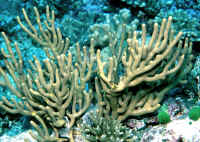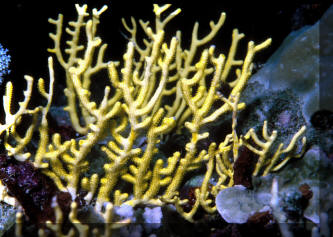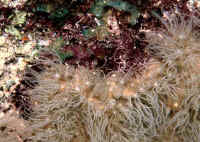|
Related FAQs: Sea Fans, Sea
Fans 2, Gorgonian, Sea Fan
Identification 1, Sea Fan ID 2,
Sea Fan ID 3,
Sea Fan ID 4, Sea
Fan Behavior, Sea Fan
Compatibility, Sea Fan
Selection, Sea Fan Systems,
Sea Fan Feeding,
Sea Fan Disease,
Sea Fan Reproduction,
Related Articles:
Octocorals,
Water Flow, How Much
is Enough,
/The Conscientious Marine
Aquarist
Sea Fans for Marine Aquaria, the Gorgonians, Order
Gorgonaceae
Part 3
To: Part
1, Part 2,
Part 4, Part 5,
Part 6
|
|
| Bob Fenner |
|
Genus Guaiagorgia:
|
Cautious Success with Guaiagorgia sp.
10/14/13
Good Afternoon Crew,
<Steve>
Thanks for all you do. In the last 7 years I have grown in skill
and understanding through WWM and would like to share some success with
a Blueberry Gorgonian.
<Ahh!>
The specimen I purchased from the LFS here in San Diego was a vibrant,
healthy looking specimen in a typical sea fan spread. The polyps were
open at the store, and have been regularly here in my 75 gallon square
tank the past three months.
The Gorg is placed mid-way down in my tank (30"x30"x18") about 16"
on center form a Vortech MP40 running at 35% on "Tidal Swell". I
have two MP40s on the back, each running at relatively low volume and
anti-syncing.
The "Lagoon" program is used overnight.
In looking at the morphology of my specimen it was obvious that most of
the polyps faced one direction, perpendicular to the fan. Based on the
limited success of many reef keepers I decided NOT to follow the norm
and pointed the polyps away from direction of water flow. I think this
is a key element in my success.
<I agree>
All new growth to date (estimated 15%), both on the tips of the branches
and on the "truck" near the base, have been away from the current. It
seems to follow that although this specimen requires a brisk current to
keep the branches free of debris, the mouths generally can only catch
food in the more tranquil direction. If the specimen is oriented
"backwards" from the start, feeding may be impossible.
The polyps are always open in the evenings... and most days, but can be
enticed easily if closed with a small amount of Cyclop-eeze in the
water.
Currently I am feeding Hikura Daphnia w/ Cyclop-eeze w/ H20 Life Marine
Fusion. The new polyps are very, very small, so the "shotgun" approach
to different feed sizes are an attempt to satisfy all, It appears to be
working.
This is a mature tank, with ample copepod production to satisfy two
Mandarins without supplemental feeding. I believe this fact plays an
important role as well, especially for the smallest polyps.
<I concur here as well>
During feeding, I slow the Vortechs to 15% on Reef Crest. This is just
enough to keep water moving randomly and let the "missed" food
recirculate.
I use a large baster to target feed, but only trickle the food out and
gently push it through the fan. In my experience these polyps will close
up at from direct "blasts". This is easy to see when you use an empty
baster.
I practiced feeding "empty" a few times to see how much flow the polyps
could handle and still grab the food. It is not much!
I feed twice a day, religiously.
I hope these notes further the cause. I am "tech heavy" so an equipment
list and parameters follow...
Steve
Equipment/Parameters:
30"x30"x18" tank
24 gallon refugium /Chaeto (reverse lighting cycle)
3" DSB (med grain)
110lbs live rock
Apex Controller
pH x 2, ORP, Temp x 2, probes
Dual Ecoxotic Canons
Karollin 1502 Calcium Reactor
Overnight Kalk drip (to counteract the CO2).
Precision Marine Skimmer (runs 24/7)
ATO
Temp: 76.9 - 77.5
pH: 8.00 - 8.18
SG: 1.026
ORP: 310 - 330 (day/night)
Nitrates: 0
Calcium: 420ppm
Magnesium: 1260ppm
Alk/DKH: 9.3
Lights: 12hrs (inclusive of 150 min ramp time at each end)
Lunar: Apex module
<Thank you for sharing! Bob Fenner>
Re: Cautious Success with Guaiagorgia sp. 11/8/2013
Good afternoon Crew... after an additional month of observations an
update on my Blueberry Gorg.
<Hey Steve>
As other reef keepers have experienced over time, my polyps started to
extend less often, and for shorter duration. Water parameters have
remained consistent, as well as feeding frequency and variety. So I
started examining the effects of light intensity,
My first observation was that the polyps that were furthest from my
light source (dual Ecoxotic canons) seemed to open sooner and longer
that the polyps closer to the light source. Knowing that this species
comes from a range down to about 75 feet or so, and often on sloped
reefs, I decided to shield the Gorg to create an imbalance in the
lighting, skewing it towards
the 460nm range.
Initially, I put a third of the specimen in complete shade with two
thirds exposed to the 460nm cannon (I blocked the10,000k). This initial
step yielded an immediate improvement. After a week, the third that
resided in total shade started to open regularly but not with the same
vigor as the 460nm portion which was back to "normal". I have since
placed the entire Gorg under the 460nm (again, no 10k) and the growth
and polyp extension has resumed. Polyps are now open appx. 20 hours per
day.
So in sum, here are my novice observations;
- Have a mature, copepod producing tank.
- Place is a diffused, moderately strong, random current.
- Face the polyps away from the primary direction of flow.
- Effect reversing tidal flow if possible.
- Feed a large variety of food sizes.
- Let the food float into the polyps, don't blast with a pipette.
- Beware of even moderate, 10k+ lighting sources.
I feel fortunate that my light sources are so narrow, it makes the
shielding fairly simple. I can see how in standard lighting systems with
48" T5s let's say, it would be difficult to create the right conditions.
<Yes; I would insert my usual statement here that most systems
are overlit, too intense and too long duration; compared with naturally
occurring parameters>
Often I've read how keeper's Gorgs stop opening and a quest for a "more
enticing" food ensues. What I believe now is that the deterioration is
due to the physical environment, and the Gorg's inability to adapt to
typical tank lighting. More light... more stress...no polyp extension...
no food...and the death spiral starts.
Temp: 76.9 - 77.5
pH: 8.00 - 8.18
SG: 1.026
ORP: 310 - 330 (day/night)
Nitrates: 0
Calcium: 420ppm
Magnesium: 1260ppm
Alk/DKH: 9.3
Lights: 12hrs (inclusive of 150 min ramp time at each end)
Lunar: Apex module
Happy reefing!
Steve
<I thank you again for sharing. Will update/addend your prev. post. Bob
Fenner>
Re: Cautious Success with Guaiagorgia sp. 12/26/13
UPDATE:
Closing in on 6 months with the Blueberry Gorg and we are thriving here
in Southern California!
<Great news!>
This winter's calendar included a two week trip out of the country and
my "fish tender" failed me at the last minute. So the Gorg (and other
species) had to survive on just a couple of frozen food cubes every few
days provided by my brother.
With no target feeding and a lack of personal attention, I resigned
myself finding a decaying Gorg upon return... Ugh. Happily, although
initially a bit unhappy with semi-closed polyps, the Gorg began to open
as usual within 24 hours and feeding/growth continues.
The more I observe this species the more I'm convinced that failure to
maintain health is due to the physical parameters of their environment
and the maturity of the tank. Now that the lighting and current is
dialed in, I am only target feeding a few days a week using ova, Coral
Fusion and Cyclop-eeze. There are some sections of the fan that receive
no target feeding at all (blocked pipette access) and they continue to
thrive.
So my recommendation continues to be for those with Blueberry
issues... stop focusing solely on the types of food. Reduce your
lighting, create moderate random flow, and regular (daily not required)
target feedings. A mature tank is a must!
Happy Reefing!
Steve
<Thank you Steve. Bob Fenner>
Ongoing Blueberry Gorg Success - Update
2/21/14
Good Evening Bob,
<Steve... your files... are an order of magnitude too large for our mail
server. Please>
Things continue to go well here in San Diego!
<Ah yes... I live in Mira Mesa>
Thought I would share a couple of pictures about 8 months along. I
estimate about 25% growth at this point, approximately 7" in diameter.
[image: Inline image 1]
These types of polyps, with the longer tentacles, typically form in high
flow areas...
[image: Inline image 2]
Thanks again for helping us with this truly fascinating hobby!
Steve
<Thank you for sharing.... just smaller pic files going forward! BobF>
|
.jpg)
.jpg)
Appears to be a Hydrozoan at the yellow pointer |
Genus Isis:
| Isis hippuris Linnaeus 1758, the Golden Sea
Fan. Indo-Pacific; Red Sea, Australia, Indonesia, Sri Lanka. To
about sixteen inches tall. Needs good current, daily feedings, low
lighting (no metal halides) for captive care. Golden in color when
polyps are extended. Closed and open colonies off the
Whitsunday's, Queensland, Australia. |

|
Bigger PIX:
The images in this table are linked
to large (desktop size) copies. Click on "framed" images
to go to the larger size. |
|

|
Genus Erythropodium:
| Erythropodium caribaeorum, Encrusting
Gorgonian. Form encrusting mats that look hairy when polyps are
extended, smooth, light colored, like leather when
retracted. |
 
|
Bigger PIX:
The images in this table are linked to large (desktop size) copies.
Click on "framed" images to go to the larger size. |
To: Part
1, Part 2,
Part 4, Part 5,
Part 6
|
|

